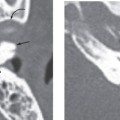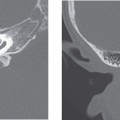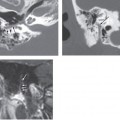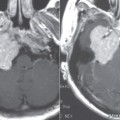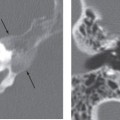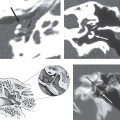CHAPTER 38 Cholesterol Granuloma of the Petrous Apex
Epidemiology
Cholesterol granuloma of the petrous apex was accepted as a distinct entity only in the mid-1980s. The most accepted pathogenesis is the obstruction-vacuum hypothesis. Mucosal engorgement occludes the narrow petrous apex outflow tracts. Absorption of trapped gas leads to a vacuum with development of negative pressure, which results in the breakdown of a few blood vessels, with pooling of blood. Anaerobic breakdown of blood products results in production of cholesterol crystals, which incites a foreign-body reaction leading to sterile inflammatory conditions, which erode the bone and lead to further hemorrhage and cholesterol formation.
An alternate exposed bone-marrow hypothesis stipulates that budding mucosa invades and replaces bone marrow of the petrous apex in young adulthood. Hemorrhage from exposed marrow leads to mucosal swelling and obstruction of draining pathways, leading to anaerobic breakdown of pooled blood into cholesterol. According to this theory, obstruction of outflow is secondary to hemorrhage from marrow and not the primary trigger for the hemorrhage. Recurrent hemorrhages lead to further enlargement and expansion of the cyst containing cholesterol crystals, forming an expansile mass at the petrous apex.
For the lesions at the petrous apex, the terms cholesterol cyst and cholesterol granuloma are interchangeable; although for middle ear and mastoid region, a granuloma is preceded by inflammation or infection, whereas a cyst is not.
Clinical Features
Cholesterol granulomas can be classified as nonaggressive or aggressive based on clinical symptoms and radiologic features. Nonaggressive types are asymptomatic and often incidentally diagnosed. The aggressive types are more common. There are three dominant clinical patterns based on involvement of adjacent structures.
In the first type, sensorineural hearing loss and tinnitus are the most common presenting symptoms. Vertigo and dizziness are other common presenting conditions. It seems that dysfunction of cranial nerve VIII is the most typical presenting disability, and involvement of the internal auditory canal radiologically is a common finding. The second type is related to a cholesterol granuloma located in the superior part of the petrous apex, in which temporal headache and facial pain are the principal presenting symptoms. This type is attributed to compression of the dura of the middle and posterior fossa. In the third type, there is involvement of the trigeminal and abducens nerves, indicating compression of the Meckel cave region. Recurrent otitis media is less common but sometimes a unique clinical feature, attributed to compression of the eustachian tube by the cyst.
Pathology
A cholesterol granuloma contains hemorrhagic debris as brownish fluid containing cholesterol crystals. Red blood cells, hemosiderin, blood vessels, chronic inflammatory cells, and multinucleate giant cells are also visualized. The granuloma is outlined by thick fibrous connective tissue.
Treatment
Stay updated, free articles. Join our Telegram channel

Full access? Get Clinical Tree


